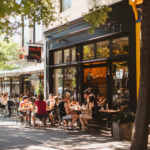The cost of everything seems to be going up these days. From the fresh veggies that we put into our dishes to the takeout boxes, we use to box up the food for our patrons. It seems like everybody is raising prices.
Ours is an industry with already painfully thin margins: it’s simply not possible to absorb all these costs ourselves without putting our businesses in jeopardy of failure.
But if we raise our prices too much we risk alienating our customers, putting our businesses in jeopardy.
So, how do we raise our prices without putting our business at risk?
The Trick To Cook A Frog: How To Always Approach Raising Prices

The trick is in an old anecdote about how to cook a frog.
Leave the heat too low and the frog will never cook. Turn it up too high and the frog will jump out of the pot.
The trick is to increase the heat little by little, over time.
And that’s exactly how we should raise prices in our restaurants as well.
Instead of raising prices by a dollar or two per dish, raise them by a quarter one month and another quarter the next month. Continue this exercise for several months.
But, how do you know you’ve raised your prices enough to make your restaurant successful longer-term?
How Do You Know You’ve Raised Prices Enough
It’s important for your business to make a profit, after all, your hard work is worth something, and if you own the place your profit it what you’re paying yourself.
So, you need to charge your customers enough for you to make a healthy profit. Even in a low-margin business like ours, you need to be charging at least 20% more than all your costs and COGS (cost of goods sold) put together.
For example, let’s say a dish costs you $10 to make per order. If you only charge $12 for it, that’s not going to leave you enough to pay your employees, your rent, your insurance, and all the rest of the costs that go into ensuring your business can operate. To calculate the per-dish costs that should be applied, figure out your total operational costs each month and then divide that by the total dishes you sell each month. This will give you a basic idea. As a rule of thumb, give yourself a cushion of 5-10% extra.
So, let’s say this bumps you up to $14 per dish, on average. To give yourself a healthy profit margin you need to add that over and above the $14 of costs associated with each dish. This would put your target price for that dish at $16.80.
But there’s something else to consider… your customers.
How To Consider Your Customers In Terms of Raising Prices
There’s an old adage in sales that says that if your customers aren’t screaming about price then your prices aren’t high enough.
That may sound good, but when you are one of several dozen similar restaurants in the same area, how do you make sure that you don’t price yourself out of the market. In other words, how do you not drive your customers to competitors with your now too-high prices?
There are several approaches that can be effective.
The first, and most important, is to listen to your customers. Especially your good, repeat customers. These are the folks who are already doing the most to support your business through their regular orders. When your customers talk to you about your business or talk to others, or post reviews, do they mention key phrases like “great value”, “reasonable prices”, or similar words? Do they praise you as giving “generous portions” or other things that can imply you are providing a lot for a little?
If so, you can raise your prices without fear of alienating your customers. And you can stop after they’ve started to notice and complain.
Another approach to pricing is to look at what your competitors are doing…
How To Consider Your Competitors In Terms of Raising Prices
Take a look at what your competitors are charging for similar dishes that you offer at your restaurant. If you find your prices are low by comparison this can give you more flexibility in raising your prices—and doing so more aggressively.
If you are pretty much in the same ballpark as your competitors, try raising your prices more slowly.
The only time you might not want to raise your prices is if you are already pricing your items higher than your competitors. BUT, if you still need to raise your prices to make a profit, don’t worry there’s still hope!
Think about other ways that you are different from your competitors already—perhaps in portion size or other ways. Or think about ways you COULD be different from your competitors if you made a slight change…
Could you give away free rice with a dish as a way of adding perceived value? Could you offer another add-on that cancels out the price increase in the customer’s mind?
How Can Joyous Help?
One of the amazing things about the Joyous platform is that you get feedback from the vast majority of orders placed through the platform. This means that you can track your customer’s satisfaction scores in real-time so that you can quickly see the impact of changes like raising your prices.
Joyous offers tools and insights to help you visualize this powerful data and see how your business is doing compared to last year, last quarter, last month.
This allows you to update your pricing strategy quickly, making sure that a price jump doesn’t cause long-term damage to your business.
Additionally, Joyous pays for promotions out of our fee, rather than charging your for them over and above what you pay to some other platforms. This can lessen the impact of overall price raises on your business by adopting a platform with built-in customer retention strategies that are proven effective at keeping customers loyal and coming back to order.
For Some Other Great Articles on How To Raise Prices
- 12 Ways To Raise Prices Without Ticking Off Customers
- How to raise prices without losing customers
- Another post on how to raise prices without losing customers














